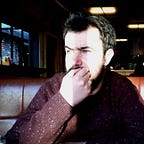It’s a dark winter morning in 1995.
Below is a rejected pitch for a series of articles on X-Men. I enjoyed the reflective quality of it, so I am including it here.
I have this memory, it’s not a particularly prominent one, but there’s a cosiness and warmth associated with it. My dad is waking me up for school. It’s a dark winter morning in 1995. Outside in South Dublin — it’s cold, black, and I will shortly be walking into that sepulchral atmosphere to catch the 46B bus. Dad brings me a glass of squeezed orange juice — and hands me the Irish Times.
He knows I like comics. Inside is an article by a journalist. I do not remember her name, but I remember the piece features Ashley Wood and Mike Allred art. The journalist describes a seemingly random assortment of contemporary comics, focusing on Allred’s Madman, and Generation X Annual 1995. The article describes the plot of the annual, identifying Mondo and the duplicitous Cordelia Frost.
And this is how I meet the character of Mondo. Previously teased in marketing material as a silhouetted figure in the group shot of the ‘next generation’ of mutants, Mondo appears in the annual following a couple of brief cameos setting up his imminent arrival. He’s a kind and chill Samoan dude.
The storyline is titled Of Leather and Lace with Scott Lobdell and Jeph Loeb credited on script and art duties shared between Ashley Wood and Shawn McManus on breakdowns, and inks by Steve Lightle, Shawn McManus, Bill Sienkiewicz, Vince Russell, Gary Chaloner and Dan Panosian. By my count that’s two Australians — Ashley Wood and Gary Chaloner — in the mix. The story opens, unpromisingly, with Cordelia Frost posed in lingerie with an oversized wine glass. We later have her confirm to Shinobi Shaw, who she is petitioning to let her join the Hellfire Club, that she is 17 years old.
In my dim memory of that newspaper article, I recall the journalist balked at this detail too.
The story continues with Cordelia’s offering, a restrained and unconscious Mondo, being kidnapped by a third-party Barrington’s hired goons. Our friendly Samoan “omnimorph” comes to on a Boston Harbor boardwalk. He is tracked down by more of the same armed goons, only for Generation X, with his treacherous ‘friend’ Cordelia in tow, arriving to help save the day.
All in all, it’s a fairly cut and dry story, not helped in making any impact by the shifts in art style. However, Mondo comes across as a kind and gentle character, open-hearted (if a little too trusting with Cordelia). I liked him instantly.
Generation X Annual 1995 was Mondo’s coming out party as a mutant superhero, and at the time it felt to me like a celebration of a character who was unassuming, from an ethnically diverse background (though given that Lobdell’s Irish dialogue was atrocious, I was sceptical of how accurate the representation of Samoa was) and again, kind.
But here’s the kicker. The Mondo written about in the Irish Times article summarising the Generation X comic that captured my imagination and led me to ‘discover’ Samoa, an island nation I’d never even heard of until 1995 — that wasn’t Mondo. Lobdell would eventually reveal in Generation X that this character was a duplicate, as part of some strange plan by Black Tom Cassidy, villain and Irish stereotype.
His superpower is a magic shillelagh! Do you know how often I even encountered a shillelagh growing up? And I went to an Irish-speaking Gaelscoil (Irish language school). Anyway.
So outside of a doomed alternate timeline version of Mondo seen in Chris Bachalo and Lobdell’s Generation Next, who sacrifices himself for a young human girl in the pits of Seattle — readers would not in fact met Mondo for another two years in issue #25. Replaced by controlled clone, the chill dude was a façade. The diversity inclusion of a Samoan mutant was a feint that narratively went nowhere.
It was not for another fifteen years that Jonathan Hickman and Rod Reis were to reintroduce Mondo as a charmingly disaffected member of the New Mutants cast, seen tagging along on their space adventure and wisely opting out of the plot involving the earlier Chris Claremont characters trying to reconnect with a space-faring Sam Guthrie.
The joke appears to be, as both a member of Generation X the team, and a 90s kid, Mondo is similarly detached from the fraught emotion of his 1980s era mutants, preferring the ironic disaffection of the coffee shop hipster. And I can live with that. His disaffection seems like a metanarratively appropriate response to a frankly confusing backstory.
But whenever I even think of Mondo I remember — a cold morning. A glass of orange juice. The crisp smell of newsprint. And my dad waking me to face the day.
